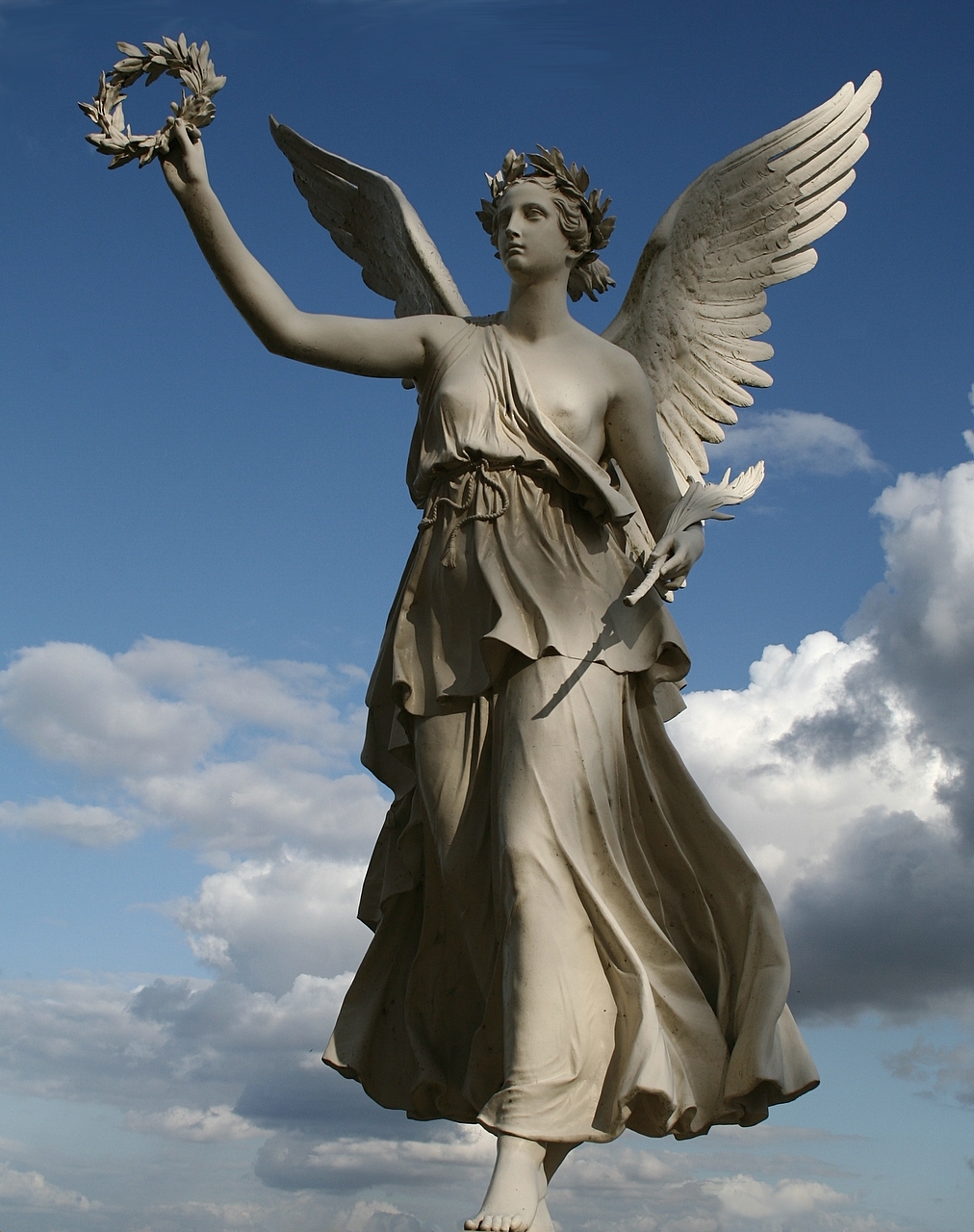

Statues and Works of Art Lost in the Fourth Crusade
By Niketas Chonates from O City of Byzantium
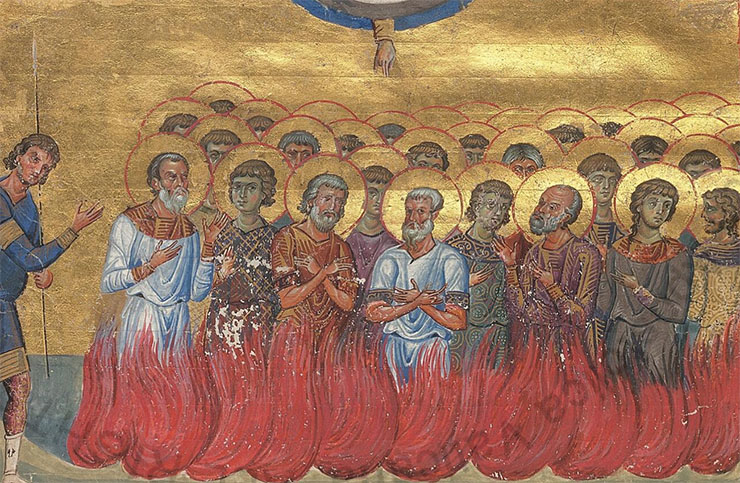 SO that our sorrows may not become more acute by protracting our history, we shall pass on from the former to a brief account of the latter.
SO that our sorrows may not become more acute by protracting our history, we shall pass on from the former to a brief account of the latter.
Soon after our empire had fallen to the lot of the French and the high priesthood had similarly been allotted to the Venetians because of the judgments known to the Lord, the maker and pilot of this terrestrial ship, there arrived from Venice as patriarch of Constantinople [end of July 1204] a certain Thomas by name. He was of middle age and fatter than a hog raised in a pit; his face was clean-shaven, as is the case with the rest of his race, and his chest was plucked smoother than pitchplaster; he wore a ring on his hand, and sometimes he wore leather coverings which were fitted to his fingers. His clerical assistants and attendants at the holy altar were seen to be identical in everything with their primate, in dress and regimen and in the cropping of the beard.

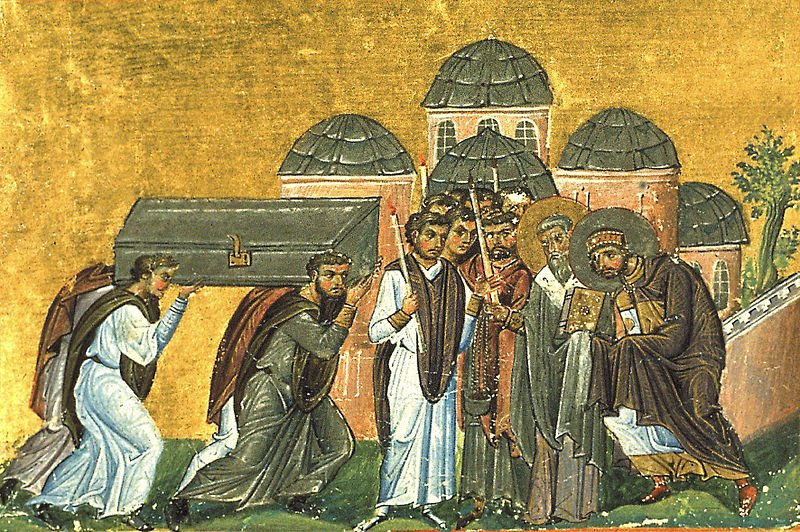 Exhibiting from the very outset, as they say, their innate love of gold, the plunderers of the queen city conceived a novel way to enrich themselves while escaping everyone's notice. They broke open the sepulchers of the emperors which were located within the Heroon so erected next to the great temple of the Disciples of Christ [Holy Apostles] and plundered them all in the night, taking with utter lawlessness whatever gold ornament, or round pearls, or radiant, precious, and incorruptible gems that were still preserved within. Finding that the corpse of Emperor Justinian had not decomposed through the long centuries, they looked upon the spectacle as a miracle, but this in no way prevented them from keeping their hands off the tomb's valuables: In other words, the Western nations spared neither the living nor the dead, but beginning with God and his servants, they displayed complete indifference and irreverence to all.
Exhibiting from the very outset, as they say, their innate love of gold, the plunderers of the queen city conceived a novel way to enrich themselves while escaping everyone's notice. They broke open the sepulchers of the emperors which were located within the Heroon so erected next to the great temple of the Disciples of Christ [Holy Apostles] and plundered them all in the night, taking with utter lawlessness whatever gold ornament, or round pearls, or radiant, precious, and incorruptible gems that were still preserved within. Finding that the corpse of Emperor Justinian had not decomposed through the long centuries, they looked upon the spectacle as a miracle, but this in no way prevented them from keeping their hands off the tomb's valuables: In other words, the Western nations spared neither the living nor the dead, but beginning with God and his servants, they displayed complete indifference and irreverence to all.
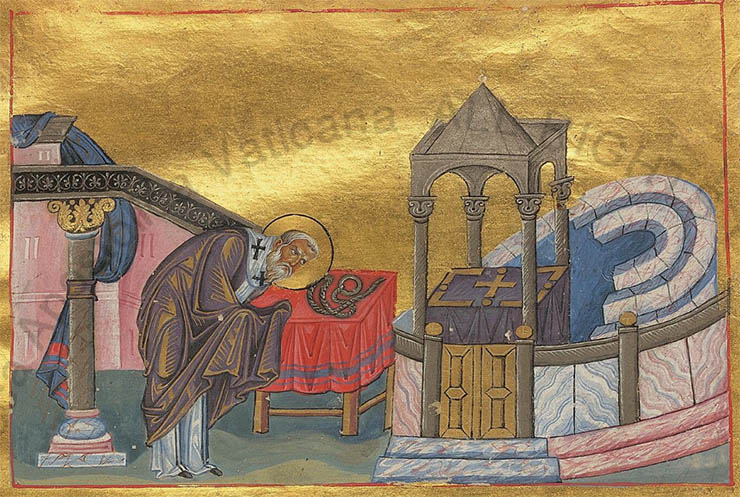 Not long afterwards, they pulled down the ciborium of the Great Church that weighed many tens of thousands of pounds of the purest silver and was thickly overlaid with gold.
Not long afterwards, they pulled down the ciborium of the Great Church that weighed many tens of thousands of pounds of the purest silver and was thickly overlaid with gold.
Because they were in want of money (for the barbarians are unable to sate their love of riches), they covetously eyed the bronze statues and consigned these to the flames. The brazen Hera standing in the Forum of Constantine was cast into a smelting furnace and minted into coins; her head could barely be carted off to the Great Palace by four yokes of oxen. Paris Alexander, standing with Aphrodite and handing to her the golden apple of Discord, was thrown down from his pedestal and cast on top of Hera.
Who, having laid his eyes on the four-sided bronze mechanical device rising up to a height nearly equal to that of the tallest columns which have been set up in many places throughout the City, did not wonder at the intricacy of its ornamentation? Every melodious bird, warbling its spring-time tunes, was carved upon it; the tasks of husbandmen, the pipes and milk pails, and the bleating sheep and bounding lambs were depicted. The wide-spread sea and schools of fish were to be seen, some caught and others shown breaking out of the nets to swim free again in the deep. There were the Erotes, shown in pairs and groups of three; innocent of clothing but armed with apples, they shook with sweet laughter as they threw these or were pelted by them. This four-sided monument terminated in a point like a pyramid, and above was suspended a female figure which turned with the first blowings of the wind, whence it was called Anemodoulion [Wind Servant].
Nonetheless, they gave over this most beautiful work to the smelters, as well as an equestrian statue of heroic form and admirable size that stood on the trapezium-shaped base in the Forum of the Bull. Some maintained that it was of Joshua, son of Nave, conjecturing that his hand was pointed towards the sun as it sank in the west, commanding it to stand still upon Gabaon. The majority were of the opinion that it was Bellerophontes, born and bred in the Peloponnesos, mounted on Pegasos; the horse was unbridled, as was Pegasos, who, according to tradition, ran freely over the plains, spurning every rider, for he could both fly through the air and race over the land. But there was an ancient tradition which came down to us and which was in the mouths of all, that under this horse's front left hoof there was buried the image of a man which, as it had been handed down to some, was of a certain Venetian; others claimed that it was of a member of some other Western nation not allied with the Romans, or that it was of a Bulgarian. As the attempt was often made to secure the hoof, the statue beneath was completely covered over and hidden from sight. When the horse was broken into pieces and committed to the flames, together with the rider, the statue was found buried beneath the horse's hoof; it was dressed in the kind of cloak that is woven from sheep's wool. Showing little concern over what was said about it, the Latins cast it also into the fire.
These barbarians, haters of the beautiful, did not allow the statues standing in the Hippodrome and other marvelous works of art to escape destruction, but all were made into coins. Thus great things were exchanged for small ones, those works fashioned at huge expense were converted into worthless copper coins.
Also overturned was Herakles, mighty in his mightiness, begotten in a triple night and placed in a basket for his crib; the lion's skin which was thrown over him looked terrifying even in bronze, almost as though it might give out a roar and frighten the helpless populace standing nearby. Herakles sat without quiver on his back, or bow in his hands, or the club before him, but with his right foot as well as his right hand extended as far as possible. He rested his left elbow on his left leg bent at the knee; deeply despondent and bewailing his misfortunes, he held his inclined head at rest in his palm, vexed by the labors which Eurystheus had designated, not out of urgency, but from envy, puffed up by the excess of fate. He was thick in the chest and broad in the shoulders, with curly hair; fat in the buttocks, strong in the arms, he was an incomparable masterpiece fashioned from first to last by the hands of Lysimachos and portrayed in the magnitude which the artist must have attributed to the real Herakles; the statue was so large that it took a cord the size of a man's belt to go round the thumb, and the shin was the size of a man. They who separated manliness from the correspondent virtues and claimed it for themselves did not allow this magnificent Herakles to remain intact, and they were responsible for much more destruction.
Together with Herakles they pulled down the ass, heavy-laden and braying as it moved along, and the ass driver following behind. These figures had been set up by Caesar Augustus at Actium (which is Nikopolis in Hellas) because when going out at night to reconnoiter Antony's troops, he met up with a man driving an ass, and on inquiring who he was and where he was going, he was told, "I am Nikon and my ass is Nikandros, and I am proceeding to the camp of Caesar.
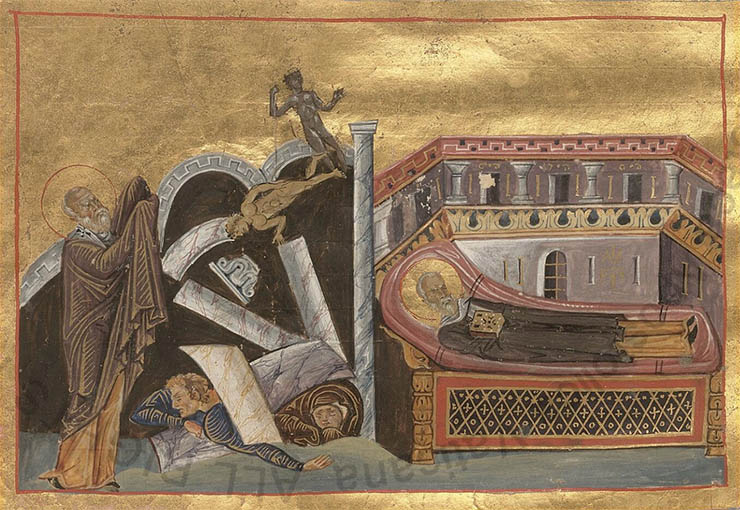 Nor, of a truth, did they keep their hands off the hyena and the she-wolf which had suckled Romulus and Romos [Remus]; for a few copper coins they delivered over the nation's ancient and venerable monuments and cast these into the smelting furnace. This was also the fate of the man wrestling with a lion, and of the Nile horse whose posterior terminated in a spiniferous and scaly tail, and of the elephant waving its proboscis. They did the same to the Sphinxes that are comely women in the front and horrible beasts in their hind parts, that move on foot in a most bizarre manner and are nimbly borne aloft on their wings, rivaling the great-winged birds; and [the same] to the unbridled, snorting horse with ears erect, playful and docile as it pranced; and to the ancient Skylla depicted leaning forward as she leaped into Odysseus' ships and devoured many of his companions: in female form down to the waist, huge-breasted and full of savagery, and below the waist divided into beasts of prey.
Nor, of a truth, did they keep their hands off the hyena and the she-wolf which had suckled Romulus and Romos [Remus]; for a few copper coins they delivered over the nation's ancient and venerable monuments and cast these into the smelting furnace. This was also the fate of the man wrestling with a lion, and of the Nile horse whose posterior terminated in a spiniferous and scaly tail, and of the elephant waving its proboscis. They did the same to the Sphinxes that are comely women in the front and horrible beasts in their hind parts, that move on foot in a most bizarre manner and are nimbly borne aloft on their wings, rivaling the great-winged birds; and [the same] to the unbridled, snorting horse with ears erect, playful and docile as it pranced; and to the ancient Skylla depicted leaning forward as she leaped into Odysseus' ships and devoured many of his companions: in female form down to the waist, huge-breasted and full of savagery, and below the waist divided into beasts of prey.
There was set up in the Hippodrome a bronze eagle, the novel device of Apollonios of Tyana, a brilliant instrument of his magic. Once, while visiting among the Byzantines, he was entreated to bring them relief from the snake bites that plagued them. Resorting to those lewd rituals whose celebrants are the demons and all those who pay special honor to their secret rites, he set up on a column an eagle, the sight of which gave pleasure to onlookers and persuaded any who delighted in its aspect to stay on like those held spellbound by the sound of the Sirens' song. His wings were aflap as though attempting flight, while a coiled snake clutched in his claws prevented its being carried aloft by striking out at the winged extremities of his body. But the venomous creature accomplished nothing, for, transfixed by the sharp claws, its attack was smothered, and it appeared to be drowsy rather than ready to give battle to the bird by clinging to his wings. While the snake breathed its last and expired with its venom unspent, the eagle exulted and, all but screeching out his victory song, hastened to lift up the serpent and bore it aloft to leave no doubt as to the outcome by the flashing of his eyes and the serpent's mortification. It was said that the very sight of the snake uncoiled and incapable of delivering a deadly bite frightened away, by its example, the remaining serpents in Byzantion, convincing them to curl up and fill their holes. This eagle's likeness was remarkable, not only because of what we have said but also because the twelve segments marked off in lines along the wings most clearly showed the hour of the day to those who looked upon it with understanding when the sun's rays were not obscured by clouds.
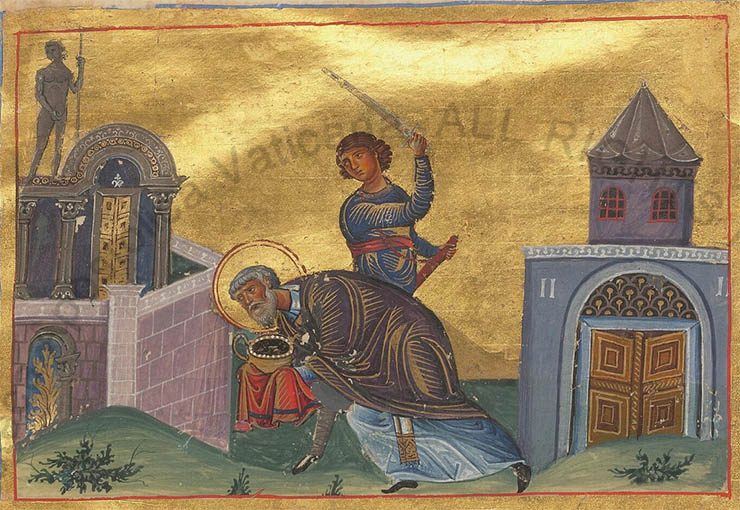 What of the white-armed, beautiful-ankled, and long-necked Helen, who mustered the entire host of the Hellenes and overthrew Troy, whence she sailed to the Nile and, after a long absence, returned to the abodes of the Laconians? Was she able to placate the implacable? Was she able to soften those men whose hearts were made of iron? On the contrary! She who had enslaved every onlooker with her beauty was wholly unable to achieve this, even though she was appareled ornately; though fashioned of bronze, she appeared as fresh as the morning dew, anointed with the moistness of erotic love on her garment, veil, diadem, and braid of hair. Her vesture was finer than spider webs, and the veil was cunningly wrought in its place; the diadem of gold and precious stones which bound the forehead was radiant, and the braid of hair that extended down to her knees, flowing down and blowing in the breeze, was bound tightly in the back with a hair band. The lips were like flower cups, slightly parted as though she were about to speak; the graceful smile, at once greeting the spectator, filled him with delight; her flashing eyes, her arched eyebrows, and the shapeliness of the rest of her body were such that they cannot be described in words and depicted for future generations.
What of the white-armed, beautiful-ankled, and long-necked Helen, who mustered the entire host of the Hellenes and overthrew Troy, whence she sailed to the Nile and, after a long absence, returned to the abodes of the Laconians? Was she able to placate the implacable? Was she able to soften those men whose hearts were made of iron? On the contrary! She who had enslaved every onlooker with her beauty was wholly unable to achieve this, even though she was appareled ornately; though fashioned of bronze, she appeared as fresh as the morning dew, anointed with the moistness of erotic love on her garment, veil, diadem, and braid of hair. Her vesture was finer than spider webs, and the veil was cunningly wrought in its place; the diadem of gold and precious stones which bound the forehead was radiant, and the braid of hair that extended down to her knees, flowing down and blowing in the breeze, was bound tightly in the back with a hair band. The lips were like flower cups, slightly parted as though she were about to speak; the graceful smile, at once greeting the spectator, filled him with delight; her flashing eyes, her arched eyebrows, and the shapeliness of the rest of her body were such that they cannot be described in words and depicted for future generations.
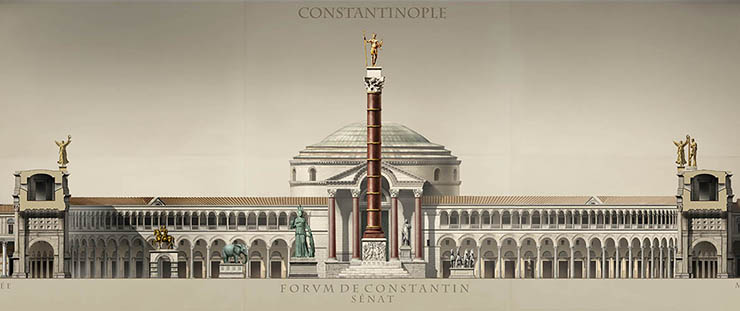 0 Helen, Tyndareus's daughter, the very essence of loveliness, off-shoot of Erotes, ward of Aphrodite, nature's most perfect gift, contested prize of Trojans and Hellenes, where is your drug granted you by Thon's wife which banishes pain and sorrow and brings forgetfulness of every ill?"' Where are your irresistible love charms? Why did you not make use of these now as you did long ago? But I suspect that the Fates had foreordained that you should succumb to the flame's fervor so that your image should no longer enflame spectators with sexual passions. It was said that these Aeneadae condemned you to the flames as retribution for Troy's having been laid waste by the firebrand because of your scandal- ous amours.165 But the gold-madness of these men does not allow me to conceive and utter such a thing, for that madness was the reason why rare and excellent works of art everywhere were given over to total destruction. Nor can I speak of their frequent selling and sending away of their women for a few coins while they attended the gambling tables and were engrossed at draughts all day long, or, being eager to engage, not in acts of prudent courage, but in irrational and mad assaults against one another, they donned the arms of Ares and set up as the prize of victory all their belongings, even their wedded wives,"" because of whom they heard themselves called fathers of children, and even that great treasure which others find difficult to sacrifice-the soul, for whose salvation men are eager to do anything. After all, how could one expect to find among these unlettered barbarians who are wholly ignorant of their ABCs, the ability to read and knowledge of those epic verses sung of you:
0 Helen, Tyndareus's daughter, the very essence of loveliness, off-shoot of Erotes, ward of Aphrodite, nature's most perfect gift, contested prize of Trojans and Hellenes, where is your drug granted you by Thon's wife which banishes pain and sorrow and brings forgetfulness of every ill?"' Where are your irresistible love charms? Why did you not make use of these now as you did long ago? But I suspect that the Fates had foreordained that you should succumb to the flame's fervor so that your image should no longer enflame spectators with sexual passions. It was said that these Aeneadae condemned you to the flames as retribution for Troy's having been laid waste by the firebrand because of your scandal- ous amours.165 But the gold-madness of these men does not allow me to conceive and utter such a thing, for that madness was the reason why rare and excellent works of art everywhere were given over to total destruction. Nor can I speak of their frequent selling and sending away of their women for a few coins while they attended the gambling tables and were engrossed at draughts all day long, or, being eager to engage, not in acts of prudent courage, but in irrational and mad assaults against one another, they donned the arms of Ares and set up as the prize of victory all their belongings, even their wedded wives,"" because of whom they heard themselves called fathers of children, and even that great treasure which others find difficult to sacrifice-the soul, for whose salvation men are eager to do anything. After all, how could one expect to find among these unlettered barbarians who are wholly ignorant of their ABCs, the ability to read and knowledge of those epic verses sung of you:
Small blame that Trojans and well-greaved Achaeans
should for such a woman long time suffer woes;
wondrously like is she to the immortal goddesses to look upon,
The following should also be recounted. There was set up on a pedestal a woman youthful in form and appearance and in the prime of life, her hair bound in the back and curled along both sides of the forehead; she was not raised up out of reach but could be touched by those who put out their hands. The right hand of this figure, with no underlying support, held in its palm a man mounted on a horse which was poised on one leg more easily than another would have clasped a wine cup. The rider was robust in body and encased in a coat of mail, with greaves on both legs, and he fiercely breathed out war; while the horse pricked up its ears as though in response to the war trumpet. With neck held high, it was fierce in countenance, the eyes betraying its eagerness to charge forth; the legs were raised high in the air, exhibiting warlike agitation.
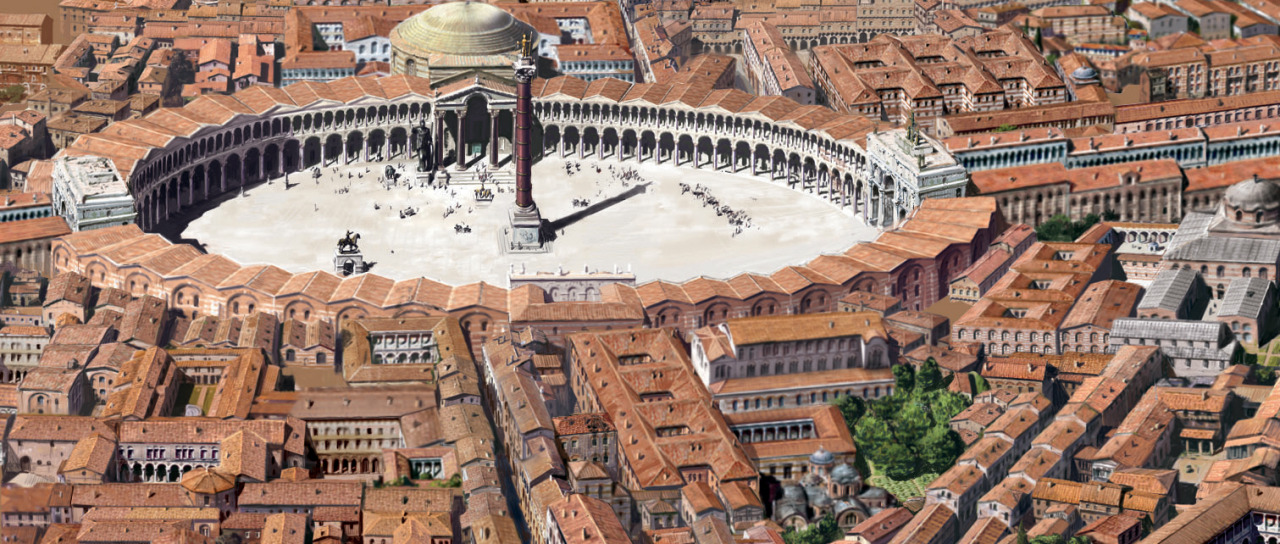 Next to this figure, very close to the eastern turn of the four-horse chariot course called Rousion [Red], statues of charioteers were set up with inscriptions of their chariot-driving skill; by the mere disposition of their hands, they exhorted the charioteers, as they approached the turning post, not to relax the reins but to hold the horses in check and to use the goad continuously and more forcefully, so that, as they wheeled round the turning post in close quarters, they should compel their rival, even though his horses were faster and he a skilled competitor, to drive on the outside of the turn and come in last.
Next to this figure, very close to the eastern turn of the four-horse chariot course called Rousion [Red], statues of charioteers were set up with inscriptions of their chariot-driving skill; by the mere disposition of their hands, they exhorted the charioteers, as they approached the turning post, not to relax the reins but to hold the horses in check and to use the goad continuously and more forcefully, so that, as they wheeled round the turning post in close quarters, they should compel their rival, even though his horses were faster and he a skilled competitor, to drive on the outside of the turn and come in last.
The following should certainly be included even though it was never my intention to describe everything. A delight to behold and almost more wondrous in craftsmanship than all the others was the brazen animal standing on a stone pedestal. It did not portray an unambiguous bull for it was short-tailed and neither had a thick throat such as the Egyptian bulls [hippopotami] have, nor was it equipped with cloven hooves. In its jaws it throttled another animal whose body was covered all over with scales so prickly that even in bronze it caused pain to him who touched them. This animal, clenched in the bull's mouth, appeared to some to be a basilisk and to others an asp; not a few conjectured that the one was a Nile bull and the other a crocodile.
I shall not concern myself with the diversity of opinions; I shall speak only of the unique struggle as the two beasts contended against one another, each suffering terribly from the wounds inflicted by the other, killing and being killed, holding fast and being held fast, winning and being overthrown by the other. For the so-called basilisk had covered the bull with bites, from the head to the soles of the hoofs; the whole body of the bull was discolored and had turned greener than frog-color as the deadly venom penetrated throughout the animal's system. As a result, the bull collapsed to its knees, and, as its vital life force faded, the eye's light was extinguished. It gave the spectators the impression that it would have fallen over long ago had not the legs supported it in an upright position. As for the basilisk, which barely struggled with its hindmost parts, it was held fast in the bull's jaws. With the bull's mouth agape, it was being strangled by the compression of the grinder teeth of the bull. It seemed to be straining in its attempt to break through the barrier of teeth in order to escape and slip through the gaping mouth, but it could not because that part of the body which follows immediately after the shoulders and the front legs and all those parts of the body joined to the tail were held secure in the distended mouth, impaled in the jaws.
In this manner, each was killed by the other. Common to both was the contest, common the defense, co-equal the victory, and death the fellow contestant. This mutual destruction and killing has persuaded me to say that these death-dealing evils, ruinous to men, not only are portrayed in images and not only happen to the bravest of beasts but frequently occur among the nations, such as those which have marched against us Romans, killing and being killed, perishing by the power of Christ who scatters those nations which wish for wars,171 and who does not rejoice in blood-shed, and who causes the just man to tread on the asp and the basilisk and to trample under foot the lion and the dragon.
DOWNLOAD THE PDF
Click here to download the complete book - O City of Byzantium with footnotes

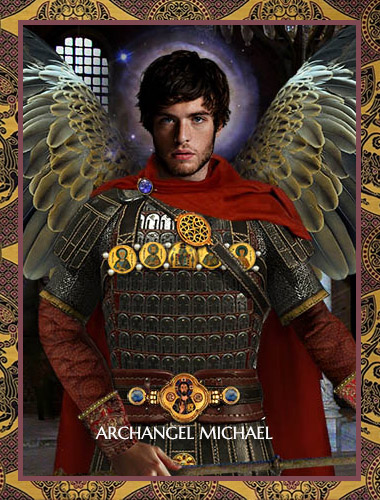


 click here for icons of christ
click here for icons of christ click here for icons of the theotokos
click here for icons of the theotokos click here for icons of angels
click here for icons of angels click here for icons of saints
click here for icons of saints








